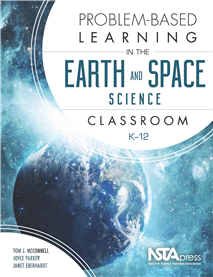New NSTA Press Book Provides Engaging Problem-Based Learning Lessons
By Carole Hayward
Posted on 2017-07-06
 Problem-based learning (PBL) offers an excellent way to capture students’ imaginations, stimulate their curiosity, and engage them in deep learning. The new NSTA Press book Problem-Based Learning in the Earth and Space Science Classroom K-12 by Tim J. McConnell, Joyce Parker, and Janet Eberhardt provides step-by-step instruction and tools to help teachers implement PBL in the classroom. Both informative and practical, the book breaks down PBL strategies into bite-sized chunks.
Problem-based learning (PBL) offers an excellent way to capture students’ imaginations, stimulate their curiosity, and engage them in deep learning. The new NSTA Press book Problem-Based Learning in the Earth and Space Science Classroom K-12 by Tim J. McConnell, Joyce Parker, and Janet Eberhardt provides step-by-step instruction and tools to help teachers implement PBL in the classroom. Both informative and practical, the book breaks down PBL strategies into bite-sized chunks.
“One of the strengths of the PBL framework is that learners are active drivers of the learning process and can develop a deeper understanding of the concepts related to the problem starting from many different levels of prior understanding. PBL is an effective strategy for both novices and advanced learners. PBL is also flexible enough to be useful in nearly any science context,” the authors state.
The key to effective implementation is teacher planning, the authors explain. That’s where this book can help. PBL is a teaching strategy that presents learners with authentic scenarios that represent “problems” to be worked out using concepts, background knowledge, research, and investigations.
The book offers classroom-tested PBL problems that were developed as part of a National Science Foundation-funded program. Problem-Based Learning Project for Teachers brought teachers together to use the PBL framework with eight content strands. As a result, the problems presented in the book have been tested and refined.
In addition to offering background information on the fundamentals of PBL, teaching strategies, and relevant research, the book provides chapters on Earth’s Landforms and Water, Rock Cycle and Plate Tectonics, Weather, and Astronomy, and breaks down lessons into bands of K-2, 3-5, 6-8, and 9-12.
For example, the Earth’s Landforms and Water chapter asks students to analyze and interpret data and construct explanations based on evidence of how geoscience processes have changed the Earth’s surface at varying times throughout its history. To put it into practice, students are asked to help a comic book publisher create scenery and story lines that include real geologic formations.
The chapter walks through the assignment, outlining each step to provide guidance and support. In a related comic book exercise featuring a Dolphin heroine, students must imagine a real underwater location and include ocean landforms that Dolphino might encounter.
For this exercise, first students would use topographic maps to find patterns in oceanic landforms as the teacher offers instruction about how to read these image patterns on the map and make sense of what they mean in real life. Next, students are asked to draw what the features would look like if seen from a submarine or underwater camera. What does a continental shelf look like in real life? What about an underwater volcano? This exercise helps students translate what they see on the map to a three-dimensional world, and when they use their imagination for the creative writing exercise they deepen their understanding. From academic to creative, the assignments allow students to use a range of skills and knowledge.
Check out the free sample chapter that explains how to facilitate Problem-Based Learning in the classroom.
Are you ready to implement PBL in your science classroom? You can buy the book in the NSTA Store here.
Also available from these authors is the companion book Problem-Based Learning in the Life Science Classroom, K–12.
Disclaimer: The views expressed in this blog post are those of the author(s) and do not necessarily reflect the official position of the National Science Teaching Association (NSTA).


